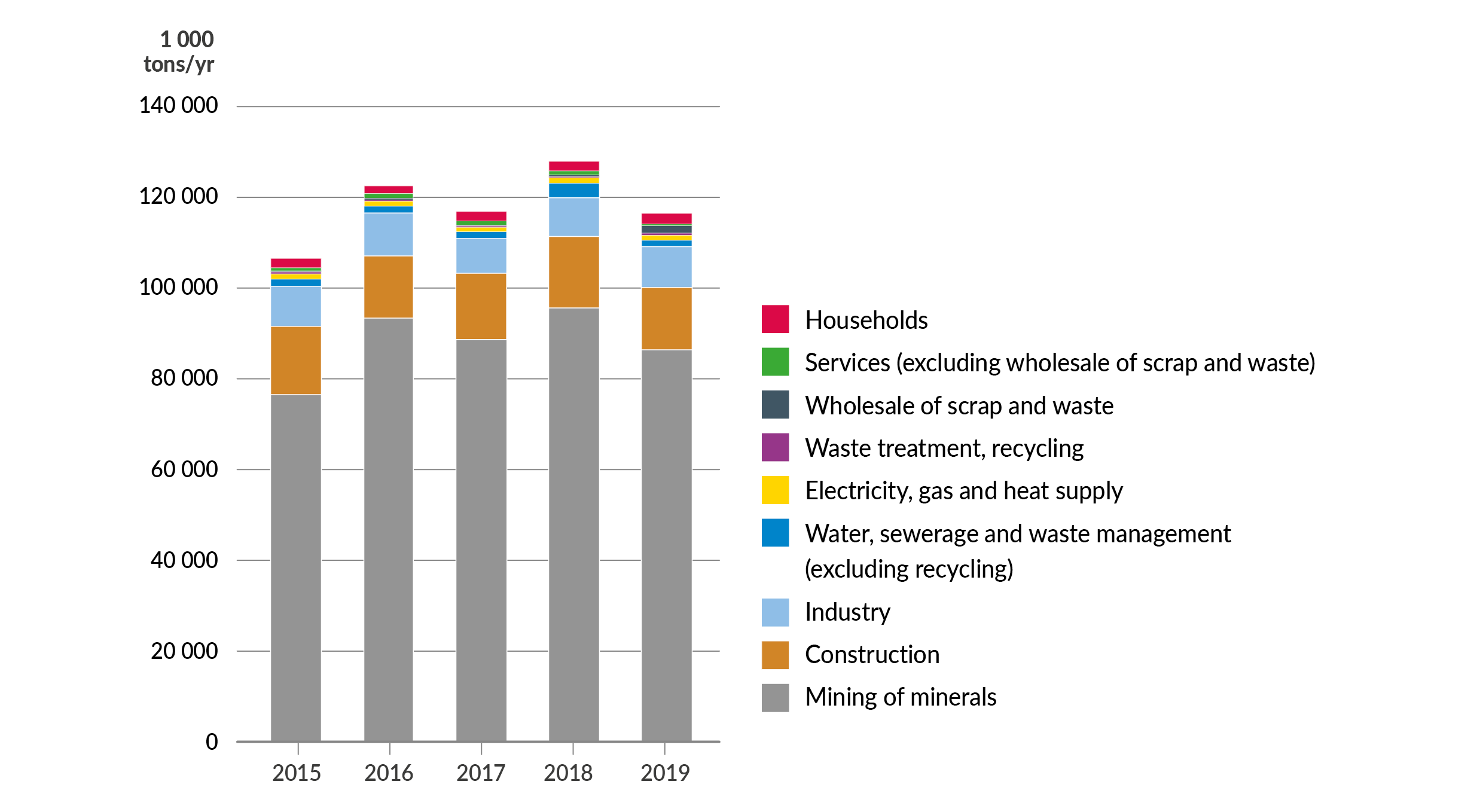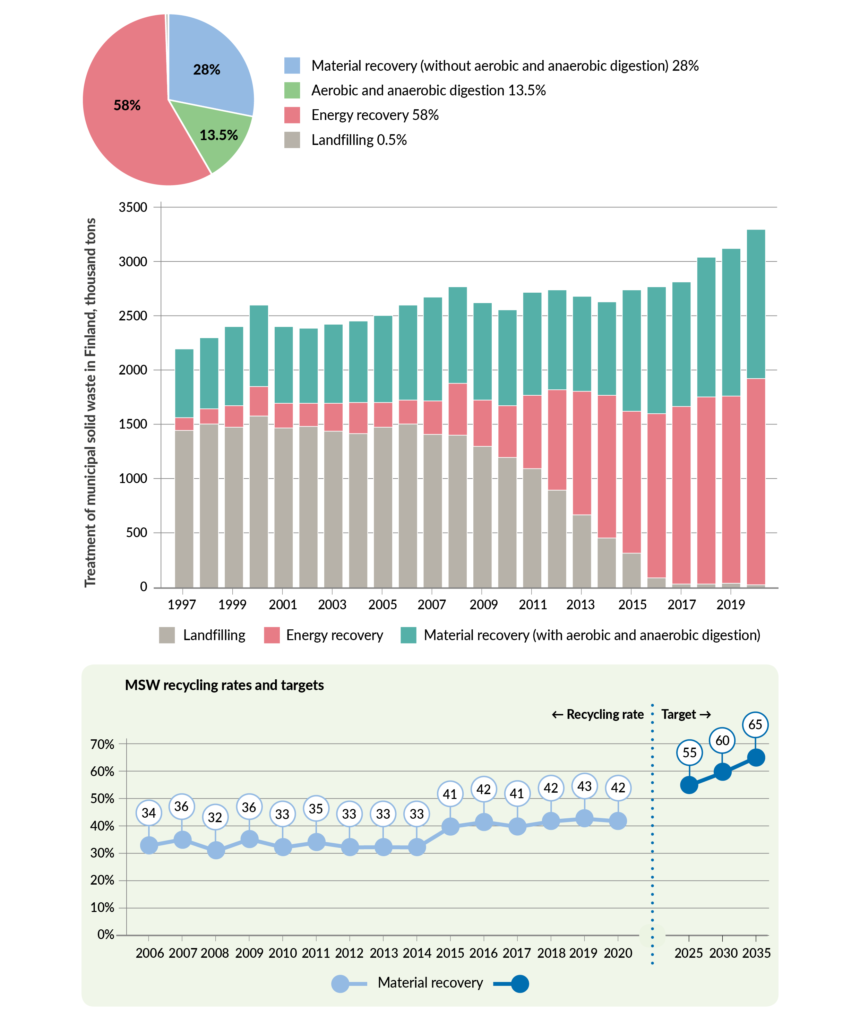Municipal solid waste 城市固体废物
What waste is municipal waste?
什么是城市垃圾?
Finland is an extractive industrial country, which is reflected in the total amount of generated waste.
芬兰是一个采掘工业国家,这反映在产生的废物总量上。
The majority of waste is generated by mining, quarrying, construction and manufacturing. The amount of municipal waste comprises 2 – 3% of the total amount of waste.
大部分废物来自采矿、采石、建筑和制造。城市垃圾量占垃圾总量的2-3%。
Although the share of MSW is rather small of all the waste generated in our societies, it is an important and visible part of the whole waste management system.
虽然城市固体废物在我们社会产生的所有废物中所占的份额相当小,但它是整个废物管理系统的重要组成部分。
It contains valuable materials but also harmful substances, it affects our living environment, and citizens themselves can strongly affect its amount and utilization.
它含有有价值的材料,但也含有有害物质,它影响着我们的生活环境,公民自己也会强烈影响它的数量和利用。

This webpage concentrates only on municipal solid waste (MSW). According to the definition of European Council Directive 2008/98/EC, municipal solid waste includes waste originating from households as well as similar waste from:
本网页仅关注城市固体废物 (MSW)。根据欧洲理事会指令 2008/98/EC 的定义,城市固体废物包括来自家庭的废物以及来自以下领域的类似废物:
- households, 家庭
- commerce and trade, 商贸,
- small businesses, 小企业,
- office buildings 办公楼
- institutions (e.g. schools, hospitals, government buildings),
机构(如学校、医院、政府大楼), - enterprises if it is similar in kind and composition to household waste and does not come from production,
企业如果其种类和成分与生活垃圾相似,并且不是来自生产, - waste from selected municipal services i.e. waste from park and garden maintenance,
来自特定市政服务的废物,即来自公园和花园维护的废物, - waste from street cleaning services (e.g. street sweepings, the content of litter containers, market cleansing waste).
来自街道清洁服务的废物(例如清扫街道、垃圾箱内容物、市场清洁废物)。
According to the European Council Directive 2008/98/EC municipal waste means:
根据欧洲理事会指令 2008/98/EC,城市垃圾是指:
(a) mixed waste and separately collected waste from households, including paper and cardboard, glass, metals, plastics, bio-waste, wood, textiles, packaging, waste electrical and electronic equipment, waste batteries and accumulators, and bulky waste, including mattresses and furniture;
(a) 混合废物和单独收集的家庭废物,包括纸张和纸板、玻璃、金属、塑料、生物废物、木材、纺织品、包装、废弃电气和电子设备、废电池和蓄电池,以及大件废物,包括床垫和家具;
(b) mixed waste and separately collected waste from other sources, where such waste is similar in nature and composition to waste from households;
(b) 混合废物和从其他来源单独收集的废物,如果此类废物在性质和成分上与家庭废物相似;
Municipal waste does not include waste from production, agriculture, forestry, fishing, septic tanks and sewage networks and treatment, including sewage sludge, end-of-life vehicles or construction and demolition waste.
城市垃圾不包括生产、农业、林业、渔业、化粪池和污水管网和处理产生的废物,包括污水污泥、报废车辆或建筑和拆除废物。

Municipal solid waste in 2020 constituted only 2.8 % of the total waste generated in Finland accounting all in all about 3.3 million tons. The share of household waste in MSW is estimated to be about 65% and the share of administration, services etc. is about 35%.
2020 年,城市固体废物仅占芬兰产生的废物总量的 2.8%,总计约 330 万吨。据估计,生活垃圾在城市固体废物中的份额约为65%,行政、服务等的份额约为35%。
Almost 3,3 million tonnes of MSW or around 596 kg per inhabitant was generated in 2020 in Finland. The amount of MSW continues to increase in relation to the Finnish population. At the beginning of the 2010s, the amount was about 500 kg/capita.
2020 年,芬兰产生了近 330 万吨城市生活垃圾,即每名居民约 596 公斤。与芬兰人口相比,城市固体废物的数量继续增加。在 2010 年代初,数量约为 500 公斤/人。
Compared to 2019, the total amount of MSW increased by 170,000 tonnes, or by over five per cent. The long-term aim of Finland has been to get the amount of MSW/capita to decrease but without success as of yet.
与2019年相比,都市固体废物总量增加了17万吨,增幅超过5%。芬兰的长期目标是减少人均城市生活垃圾的数量,但目前尚未成功。
In 2020, the share of material recovery of MSW was 42%
2020年,城市固体废物的物料回收率为42%
Material recovery includes also the recycling of biowaste by composting and anaerobic digestion, which comprises almost 14 percentage units. Anaerobic digestion is considered as material recovery as it generates biogas, which can be utilized as fuel.
材料回收还包括通过堆肥和厌氧消化回收生物废物,其中包括近 14% 的单位。厌氧消化被认为是材料回收,因为它会产生沼气,沼气可以用作燃料。
Also, the recycling rates are high for some separately collected fractions: in 2019 for paperboard packages 116%, glass packages 98% and metal packages 85%. Since 2012 energy recovery (incineration) of waste has been the most significant treatment mode of MSW now comprising 58 %.
此外,一些单独收集的馏分的回收率很高:2019 年纸板包装为 116%,玻璃包装为 98%,金属包装为 85%。自 2012 年以来,废物的能量回收(焚烧)一直是城市固体废物最重要的处理方式,目前占 58%。
Energy recovery of MSW is mainly based on the combined production of electricity and heat (CHP) that is often utilized in district heating networks.
城市生活垃圾的能量回收主要基于电力和热能(CHP)的联合生产,通常用于区域供热网络。

Municipal waste treatment (material recycling, energy recovery and landfilling in Finland, years 2000-2020, 1000 tons). Source: Statistics Finland
城市垃圾处理(芬兰的材料回收、能源回收和填埋,2000-2020年,1000吨)。资料来源:芬兰统计局
Share of landfill disposal of MSW remained low, at around 0.9 % due to restricting legislation. Among the materials still landfilled in Finland are residual waste which cannot be recovered, such as aggregate, asbestos, ash and non-combustible wastes.
由于限制性立法,城市固体废物的堆填区处置比例仍然很低,约为0.9%。在芬兰仍然被填埋的材料中,有无法回收的残余废物,如骨料、石棉、灰烬和不可燃废物。
The percentage of landfilled MSW has decreased rapidly in the past couple of decades from almost 66 % to below one. Although the amount of landfilled MSW is really low at the moment, the share of material recovery is also still too low.
在过去的几十年里,填埋城市固体废物的比例迅速下降,从近66%下降到1%以下。虽然目前填埋城市固体废物的数量确实很低,但材料回收的份额仍然太低。
The aim set by the EU for the material recovery of MSW is 55% in 2025, 60% in 2030 and 65% in 2035.
欧盟设定的都市固体废物回收率为2025年达到55%,2030年达到60%,2035年达到65%。

